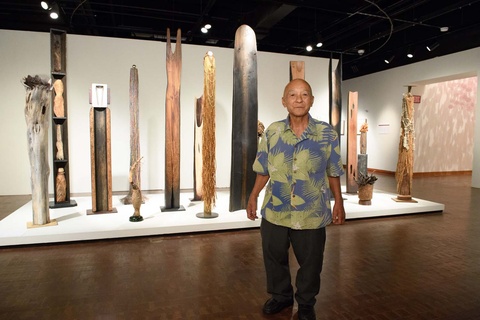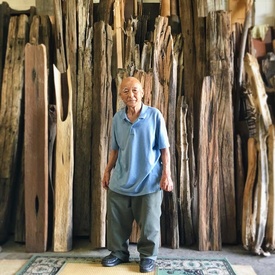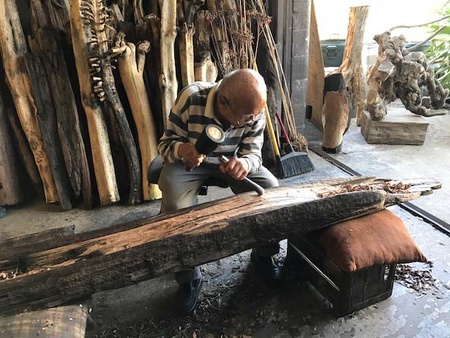
I was deeply saddened to learn of the recent passing of the sculptor Kenzi Shiokava on June 18, 2021. I had the pleasure of interviewing him in his remarkable studio in 2017 for the catalog that accompanied the Japanese American National Museum’s exhibition, Transpacific Borderlands: The Art of Japanese Diaspora in Lima, Los Angeles, Mexico City, and São Paulo. Amidst the comfortable chaos of lumber, hand tools, collectables, and books, Kenzi beamed with joy at the sudden attention he had started to receive in recent years after nearly a lifetime of toiling away in anonymity. I present this piece again as a tribute to an artist who was above all dedicated to his work, regardless of who took notice—but with gratitude that we were able to play a part in sharing his work.
* * * * *
Approaching Kenzi Shiokava’s studio in South Central LA is a disorienting experience. It is a non-descript building, along a commercial strip of El Segundo Boulevard in Compton, with a plain metal security door. For a second, you may wonder if you’ve come to the wrong place. When you call out for the resident artist, it may take a little time for him to let you in—he is busy, at work, doing things. The man who greets you when the door finally opens is a revelation: he is of short stature but immediately his exuberance, his joy and love of life, his incredible presence, envelop you. When you look over his shoulder into the rest of his deceptively large space, you are immediately overwhelmed—the way a child in a candy store might be—with the sheer number of things that are there. You take it all in, and you know that you are about to be treated to something wonderful.
Born in 1938 in São Paulo, Brazil, to Japanese immigrants from Kagoshima Prefecture, Kenzi arrived in California in 1964 at the age of 25, following one of his sisters who had come earlier. He didn’t have any particular plans at first, but it seemed like an opportunity for new experiences and a chance to earn some decent money. But in the US—as he explains in between offering you profound advice for how to live and observations about the world—something transformative happened. In Brazil, he had planned to be a doctor. In the US, he attended art school.
It was in his fourth year at Chouinard Art Institute (now California Institute of the Arts), that he discovered his life’s calling. Until that year, he had been focusing on paintings, but felt that this medium was more about mastering techniques and too much an imitation of the work of others. In his fourth year, he needed to work with wood and produce sculptures for the first time. After weeks of putting off actually starting on his work, he finally settled down with a piece of wood one day. And he felt something well up from somewhere deep inside of him. It was a visceral connection between the material, the process of carving, his spiritual core. He shares, with a glowing smile on his face and gesturing with his beautifully worn hands, how in that moment he knew how he would spend the rest of his life.
The other important thing that happened in the US was Kenzi discovered a new sense of connection to his Japanese identity. In Brazil, he hadn’t thought as deeply about what it meant to be the child of Japanese immigrants. But in California, he started learning more about Japanese culture, and felt every new discovery resonate with something already inside of him. Reading D.T. Suzuki’s books about Zen inspired him even as they seemed to confirm beliefs and sensibilities he already possessed. Other aspects of Japanese culture drew him in as well. In Brazil, he had felt strangely out of place, but without knowing exactly why. In California, where he connected with his “Japanese side,” he also began to feel at home. He attributes this partly to age; by this time, he was finally in his mid-twenties and interested and capable of reflecting on who he was, his roots, and holding together a comprehensive Japanese and Brazilian identity.
Now, both are equally important to him: just as he was deeply moved reading about Zen philosophy in his twenties, now that he is almost eighty, he goes almost weekly to the live jazz performances at LACMA to dance. There cannot be one without the other: he is Japanese-Brazilian to the very core of his body.
But his range of interests is limitless, and he finds inspiration everywhere. He keeps reminding you that there cannot be an end to growth—otherwise, you will be mediocre. And he has no patience for mediocrity. To really excel, to attain a “high level,” you must keep seeking knowledge, and expanding your interests. He enthusiastically shares his love for jazz, his horror at the bloody persecution of Roman Catholics in Elizabethan England, his belief that love is at the core of all things.
And his workspace reflects his irrepressible love and enthusiasm for everything: it is like being in a wonderful used bookstore, a woodworking studio, a cabinet of curiosities, and at the feet of a master, all at the same time. There is the faint smell of wood, the comfortable layer of dust of a well-loved space, books (and books and books), records, figurines and objects carefully tucked into curio cabinets and shelves, icons, and photographs. The photographs of his family—and his parents when they were young, in particular—remind you of how far this man has come from his home in Brazil, and yet how he is a chip off the old block.
When asked to explain the stories behind these photos, he picks up one of his father in a svelte chauffeur’s uniform, standing in front of the stately car he drove for a senator, from around 1936; he says, “See! My father, he was looking for opportunities, to reach a higher level!” The passport photo of his mother at the tender age of 18, likewise, elicits enthusiasm and affection. His father had returned to Japan to marry, and this young woman had agreed to travel to the far-off land of Brazil with him. They were adventurers too, like their son, and his respect for and recognition of their brave act that made his possible is palpable as he sifts through their photographs.
Kenzi also explains that he is a spiritual person, and evidence of this is interspersed throughout his space. There are crucifixes incorporated into his many assemblages displayed around his studio. But most emblematic is the model Japanese shrine structure that sits in a corner, with a small statue of the Virgin Mary standing within. He is religious—Catholic—and for him, placing the Virgin there makes as much sense as anything.
He emphatically continues that morality is politics, whereas religion is defined by love, and for him, love is what matters. There is certainly love in this space, from the way that Kenzi has carefully arranged his well-worn chisels to the plastic fruit, figurines, and other objects in their cubbyholes, to the painstakingly shelved records and books, to the sculpture representing the Brazilian folk heroine Maria Bonita that is also a tribute to his deceased younger sister.
Most of all, it is Kenzi himself who exudes love: love for his sculptures, love for his craft, love for each piece in each assemblage, love for learning, growing, developing even further. He is restless with a youthful energy, impatient with how much there is still to do, vibrating with an eagerness to make another discovery.
* This essay is based on a visit to Kenzi Shiokava’s studio by Emily Anderson and Claudia Sobral on July 14, 2017. It was originally published in the exhibition catalogue of Transpacific Borderlands: The Art of Japanese Diaspora in Lima, Los Angeles, Mexico City, and São Paulo in 2017.
Watch "Transpacific Borderlands" Artist Profile: Kenzi Shiokava
© 2017 Emily Anderson / Japanese American National Museum





